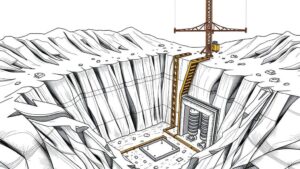The Role of Slag Management in Agricola’s Smelting Practices
The Role of Slag Management in Agricola’s Smelting Practices
Slag management is a crucial aspect of smelting operations, historically and in contemporary metallurgy. The polymath Georgius Agricola recognized the importance of effective slag management in his seminal work, De Re Metallica, published in 1556. This article examines Agricola’s contributions to smelting practices, focusing on the role of slag management and its implications for both historical and modern metallurgy.
Understanding Slag in Metallurgical Processes
Slag is a byproduct generated during the smelting process, which involves the extraction of metals from their ores. When metal ores are heated, impurities such as silicates, oxides, and other undesired materials separate from the metal and form slag. The management of this byproduct is essential for improving efficiency, reducing environmental impact, and maximizing the yield of recoverable metals.
Agricolas Insights on Slag Management
Agricola emphasized the significance of both the physical and chemical properties of slag in optimizing smelting operations. He outlined several methods for effective slag management, which included:
- Controlling the slag composition to enhance metal recovery.
- Utilizing slag as a secondary resource for various applications.
- Useing methods for improving slag separation and disposal.
Slag Composition and Metal Recovery
The composition of slag can greatly influence the efficiency of metal recovery. Agricola noted that the addition of flux materials, such as limestone or other alkaline substances, could improve the melting process and lower the melting point of impurities. This practice not only aids in separating valuable metals but also minimizes energy consumption.
For example, in modern copper smelting, the addition of silica and flux can facilitate the formation of a lighter slag that can be easily removed, allowing for higher yields of pure metal extraction. According to the International Copper Study Group, effective slag management can enhance metal recovery rates by as much as 5-10%.
Environmental Considerations of Slag Management
Agricola’s methods for managing slag were not only practical for enhancing smelting efficiency but also addressed environmental concerns. Historically, poorly managed slag could lead to land degradation and water pollution.
In contemporary practices, slag is often repurposed in construction and road building. For example, granulated blast-furnace slag is utilized as a supplementary cementitious material, which can replace a portion of Portland cement in concrete production. This not only reduces waste but also minimizes the carbon footprint associated with cement manufacturing.
Case Studies in Modern Slag Management
Several companies today employ practices inspired by Agricolas focus on slag management. One noteworthy example is the use of hydrometallurgical methods to treat slag, recovering valuable metals that may have been previously overlooked.
- In Sweden, Boliden operates smelters that recycle copper and other metals from slag efficiently through processes developed from principles outlined by Agricola.
- Similarly, in South Africa, mining companies are now reclaiming precious metals from tailings and slags, yielding significant financial returns while minimizing environmental harm.
Implications for Future Metallurgical Practices
Agricola’s emphasis on the careful management of slag provides valuable lessons for modern metallurgy. As resource scarcity and environmental concerns rise, the insight gained from effective slag management practices will prove vital for the sustainability of metal production. The principles he espoused can translate into innovative practices in recycling and material recovery.
Conclusion and Actionable Takeaways
To wrap up, slag management plays an integral role in both Agricola’s time and modern smelting practices. By controlling slag composition, repurposing waste, and prioritizing environmental considerations, the principles laid out by Agricola remain relevant today. For metallurgical professionals, implementing effective slag management strategies can lead to:
- Enhanced metal recovery and operational efficiency.
- Reduced environmental impact and improved sustainability.
- Increased profitability through the repurposing of waste materials.
As we move forward, embracing these strategies will ensure that metallurgical practices are both efficient and sustainable, honoring the legacy of pioneers like Agricola while addressing the needs of the present and future.


